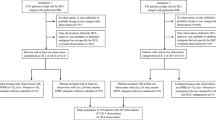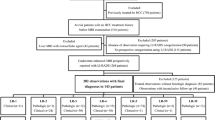Abstract
Purpose
To evaluate the role of ancillary features (AFs) of Liver Imaging Reporting and Data System (LI-RADS) in the diagnostic performance of small HCC (≤ 20 mm) on gadoxetic acid-enhanced MRI.
Methods
A total of 154 patients with 183 hepatic observations were analysed in this retrospective study. Observations were categorized using only major features (MFs) and combined MFs and AFs. Independently significant AFs were identified through logistic regression analysis, and upgraded LR-5 criteria were developed using these as new MFs. The diagnostic performance of the modified LI-RADS (mLI-RADS) was calculated and compared with that of LI-RADS v2018 using McNemar’s test.
Results
Restricted diffusion, transitional and hepatobiliary phase hypointensity were independently significant AFs. The mLI-RADS a, c, e, g, h and i (upgraded LR-4 lesions that were categorized using only MFs to LR-5 using a certain or any one, two, three of the above AFs as new MFs) yielded a significantly greater sensitivity than that of the LI-RADS v2018 (68.0%, 69.1%, 69.1%, 69.1%, 69.1%, 68.0% vs. 61.9%, all p < 0.05), whereas the specificities were not significantly different (84.9%, 86.0%, 84.9%, 83.7%, 84.9%, 87.2% vs. 88.4% all p > 0.05). When independently significant AFs were used to upgrade the LR-4 nodules categorized by combined MFs and AFs (mLI-RADS b, d and f), the sensitivities were improved, but the specificities were decreased (all p < 0.05).
Conclusions
Independently significant AFs may be used to upgrade an observation from LR-4 (categorized only using MFs) to LR-5, which can improve diagnostic performance for small HCC.
Graphical abstract



Similar content being viewed by others
References
American College of Radiology. CT/MRI LI-RADS® v2018.Acr.org Web site. 2020. https://www.acr.org/Clinical-Resources/Reporting-and-Data-Systems/LI-RADS/CT-MRI-LI-RADS-v2018. Accessed 6 November 2020.
Lim K, Kwon H, Cho J, et al. (2022) Added value of enhanced CT on LR-3 and LR-4 observation of Gd-EOB-DTPA MRI for the diagnosis of HCC: are CT and MR washout features interchangeable? Br J Radiol 95 (1132): 20210738. https://doi.org/10.1259/bjr.20210738.
Song JS, Choi EJ, Hwang SB, et al. (2019) LI-RADS v2014 categorization of hepatocellular carcinoma:intraindividual comparison between gadopentetate dimeglumine-enhanced MRI and gadoxetic acid-enhanced MRI. Eur Radiol 29 (1): 401-410. https://doi.org/10.1007/s00330-018-5559-z.
Lee S, Kim MJ, Kim SS, et al. (2020) Mitchell, Retrospective comparison of EASL 2018 and LI-RADS 2018 for the noninvasive diagnosis of hepatocellular carcinoma using magnetic resonance imaging. Hepatol Int 14 (1): 70-79. https://doi.org/10.1007/s12072-019-10002-3.
Hope TA, Fowler KJ, Sirlin CB, et al. (2015) Hepatobiliary agentsand their role in LI-RADS. Abdom Imaging 40(3): 613-625. https://doi.org/10.1007/s00261-014-0227-5.
Lee S, Kim SS, Bae H, et al. (2021) Application of Liver Imaging Reporting and Data System version 2018 ancillary features to upgrade from LR-4 to LR-5 on gadoxetic acid–enhanced MRI. Eur Radiol 31 (2): 855-863. https://doi.org/10.1007/s00330-020-07146-4.
Cerny M, Bergeron C, Billiard JS, et al. (2018) LI-RADS for MR imaging diagnosis of hepatocellular carcinoma: performance of major and ancillary features. Radiology 288 (1):118-128. https://doi.org/10.1148/radiol.2018171678.
Choi SH, Byun JH, Lim YS, et al. (2018) Liver Imaging Reporting and Data System: patient outcomes for category 4 and 5 nodules. Radiology 287(2):515-524. https://doi.org/10.1148/radiol.2018170748.
Shin J, Lee S, Yoon JK, et al. (2021) LI-RADS Major Features on MRI for Diagnosing Hepatocellular Carcinoma: A Systematic Review and Meta-Analysis. J Magn Reson Imaging 54(2):518-525. https://doi.org/10.1002/jmri.27570.
Lee SY, Kim MJ, Kim SS, et al. (2020) Retrospective comparison of EASL 2018 and LI-RADS 2018 for the noninvasive diagnosis of hepatocellular carcinoma using magnetic resonance imaging. Hepatol Int 14(1):70-79. https://doi.org/10.1007/s12072-019-10002-3.
Gaetano AMD, Catalano M, Pompili M, et al. (2019) Critical analysis of major and ancillary features of LI-RADS v2018 in the differentiation of small (≤ 2 cm) hepatocellular carcinoma from dysplastic nodules with gadobenate dimeglumine-enhanced magnetic resonance imaging. Eur Rev Med Pharmacol Sci 23 (18): 7786-7801. https://doi.org/10.26355/eurrev_201909_18988.
Joo I, Kim SY, Kang TW, et al. (2020) Radiologic-Pathologic Correlation of Hepatobiliary Phase Hypointense Nodules without Arterial Phase Hyperenhancement at Gadoxetic Acid-enhanced MRI: A Multicenter Study. Radiology 296(2):335-345. https://doi.org/10.1148/radiol.2020192275.
Hwang SH, Park S, Han K, et al. (2019) Optimal lexicon of gadoxetic acid-enhanced magnetic resonance imaging for the diagnosis of hepatocellular carcinoma modified from LI-RADS. Abdom Radiol (NY) 44 (9): 3078-3088. https://doi.org/10.1007/s00261-019-02077-1.
Vernuccio F, Cannella R, Meyer M, et al. (2019) LI-RADS: Diagnostic Performance of Hepatobiliary Phase Hypointensity and Major Imaging Features of LR-3 and LR-4 Lesions Measuring 10-19 mm With Arterial Phase Hyperenhancement. AJR Am J Roentgenol 213(2):W57-W65. https://doi.org/10.2214/AJR.18.20979.
Renzulli M, Biselli M, Brocchi S, et al. (2018) New hallmark of hepatocellular carcinoma, early hepatocellular carcinoma and high-grade dysplastic nodules on Gd-EOB-DTPA MRI in patients with cirrhosis: a new diagnostic algorithm. Gut 67(9):1674-1682. https://doi.org/10.1136/gutjnl-2017-315384.
Xie SD, Zhang Y, Chen JB, et al. (2022) Can modified LI‑RADS increase the sensitivity of LI‑RADS v2018 for the diagnosis of 10-19 mm hepatocellular carcinoma on gadoxetic acid‑enhanced MRI? Abdom Radiol (NY) 47 (2): 596-607. https://doi.org/10.1007/s00261-021-03339-7.
Funding
This study was supported by the grants form Tianjin Key Medical Discipline (Specialty) Construction Project (TJYXZDXK-074C), Tianjin Health Science and Technology Project (TJWJ2022QN045), and Tianjin Health Project of Science and Technology (TJWJ2022XK027).
Author information
Authors and Affiliations
Contributions
RL and WH contributed equally to this work. RL: conception, literature research, imaging analysis, manuscript drafting, final manuscript approval. WH: conception, literature research, imaging analysis, manuscript drafting, final manuscript approval. DW: literature research, imaging analysis, manuscript drafting. JW: literature research; data curation; manuscript editing. ZG: data interpretation; literature review; visual abstract. KJ: final manuscript approval.
Corresponding author
Ethics declarations
Conflict of interest
The authors declare that they have no known competing financial interests or personal relationships that could have appeared to influence the work reported in this paper.
Additional information
Publisher's Note
Springer Nature remains neutral with regard to jurisdictional claims in published maps and institutional affiliations.
Rights and permissions
Springer Nature or its licensor (e.g. a society or other partner) holds exclusive rights to this article under a publishing agreement with the author(s) or other rightsholder(s); author self-archiving of the accepted manuscript version of this article is solely governed by the terms of such publishing agreement and applicable law.
About this article
Cite this article
Lyu, R., Hu, W., Wang, D. et al. LI-RADS v2018: utilizing ancillary features on gadoxetic acid-enhanced MRI to improve the diagnostic performance of small hapatocellular carcinoma (≤ 20 mm). Abdom Radiol 48, 1987–1994 (2023). https://doi.org/10.1007/s00261-023-03871-8
Received:
Revised:
Accepted:
Published:
Issue Date:
DOI: https://doi.org/10.1007/s00261-023-03871-8




